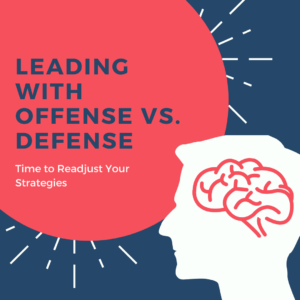 I recently had the opportunity to chat with Amy Hedin, the CEO and an executive coach at Human Point on her blogging podcast, “Coaching Coffee Break,” about how organizations should look at their strategic plans given the current realities of our new COVID-19 world.
I recently had the opportunity to chat with Amy Hedin, the CEO and an executive coach at Human Point on her blogging podcast, “Coaching Coffee Break,” about how organizations should look at their strategic plans given the current realities of our new COVID-19 world.
Bottom line, you need to shift your strategy to one that plays more offense than defense. If you remain on defense, you’ll be protecting that which might not ever exist again. As I discussed in my last blog, “Leading Into the Unknown,” there will be plenty of opportunities, but if you remain in the “protect” or defensive mode of what you started the year out with, you’ll miss them. And you’ll be defending a castle whose foundation has permanently shifted – and possibly not for the better.
So, does this mean that all your hard work, all your ideas, and all your strategic goals need to be thrown by the wayside? Of course not, but the future looks completely different than it did 6 months ago. Remember that when you do a SWOT (Strengths, Weaknesses, Opportunities, Threats), the S and W are internal, and the O and T are external. We just had a MAJOR external Threat that upended everything – our employees, our customers, and our way of life. Which means even those who had planned for some sort of a major threat to their business, may not have been fully prepared for the impact of a major pandemic.
Just look at our government with all the resources at their disposal. They were unable to use the plan to their advantage and we are now seeing the consequences of that playing out. Trying to make yesterday come back is not going to make it so. There are no magic ruby slippers.
What you can do is play offense. Consider what opportunities have sprouted since the pandemic took hold? The following reflection questions will help you:
- How are our competitors doing? Are their merger opportunities?
- Now that we know people can work from home successfully, what does that mean for our workforce? Our locations? Our customers?
- What products do we need to create based on different needs than 6 months ago?
- How are clients/customers going to use our products or services differently than before?
- How are they going to make buying decisions?
- What does this mean for my organization structure?
- What infrastructure will I need or not?
These are just some of the ways you can rewrite your strategies so that they are iterative and agile – the plan is almost obsolete the minute you finish it. As someone once said, it’s the planning, not the plan that’s important. Keeping it alive, fresh, relevant and most importantly in front of you is what matters. Predicting the future has never been easy, but those who are willing to change, to reinvent, to evolve and to innovate are the ones who will win at offense every time.
